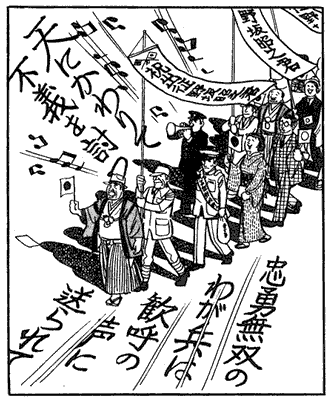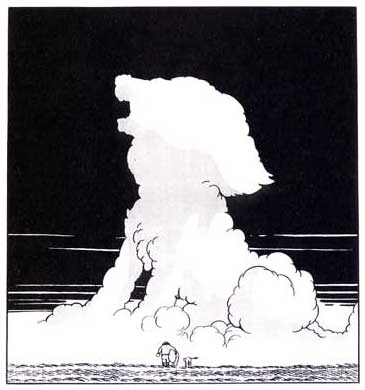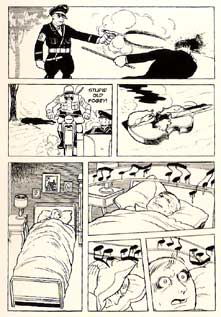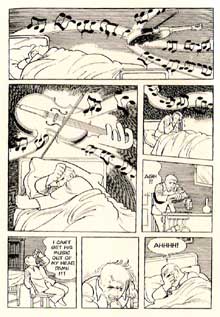'Astroboy'.
Osamu Tezuka is a towering figure in Japanese comics, A.K.A. manga. During his younger years, he was strongly influenced by Carl Barks, Walt Disney, Max Fleischer, Floyd Gottfredson, Ub Iwerks, Paul Terry and, from his own country, Shaka Bontaro, Rakuten Kitazawa and Fukujiro Yokoi. In 1946, he published his first comic series 'Machan no Nikkicho' ('Machan's Diary') for the children's magazine Mainichi Shogakusei Shinbun, while he was a student at Osaka University. His first best-seller, 'Shin Takarajima' ('New Treasure Island') appeared in 1947. The book was directly inspired by 'Donald Duck Finds Pirate Gold' by Carl Barks and Jack Hannah.
'Adolf'.
Dozens of other successes followed in all kinds of genres, like science fiction, horror, fantasy and funny animal stories. Tezuka created manga adaptations of 'King Kong' (1947), 'Faust' (1949), 'Pinocchio' (1952), 'Round the World in 80 Days' (1953) and 'Crime and Punishment' (1953). After the science fiction feature 'Lost World' in 1948, he made the ecological saga 'Jungle Tatei' ('Kimba the White Lion', 1950-1954), serialized in Manga Shônen. In 1951, he created his signature character 'Atom Taishi', later retitled 'Tetsuwan-Atom'. Know internationally as 'Astro Boy', this comic became Tezuka's best-known work.
'Phoenix'.
Other creations of the 1950s and 1960s by Tezuka are the girls' strip 'Ribon no Kishi' ('Ribon the Knight'), the western 'Lemon Kid', 'Ogon no Trunk' ('The Golden Trunk'), and the science fiction stories 'Majin Garon', 'O'Man', 'Captain Ken', 'Big X' and 'W3'. Later followed the horror tale 'Vampire', 'Hinotori', the historical strip 'Dororo' and the medical series 'Black Jack'.
'Ignis'.
'Black Jack' ran in Shonen Champion for six years, starting in 1973, and has led to live-action and animated movies, as well as a musical version. In 1972, Tezuka started to work on 'Buddha', a manga adaptation of Buddha's life. Special mention should be given to 'Adolf ni Tsugu', an epic tale of more than 1,000 pages, about World War II and beyond. His final comics work was 'Hidamari no Ki' ('A Tree in the Sun').
'Shintaka Rajima'.
From a very young age, Osamu Tezuka had been a great fan of Disney animation and eventually founded his own animation studio. He created the first Japanese animated TV show ('Astroboy', 1963) and produced the first Japanese color TV series (Jungle Tatei, 1965). Influenced by Disney and old movies, Tezuka has in turn influenced countless numbers of Japanese cartoonists. Among the many artists once employed by Osamu Tezuka in his comics and animation studio have been Toshio Ban and Hideko Mizuno.
In 1989, the film 'Animated Self-Portraits' was made, which featured contributions by animators from all over the world, giving audiences a taste of their signature styles. Alongside Tezuka, the film also featured contributions by such greats as Jirí Barta, Sally Cruikshank, Jan Svankmajer and Osamu Tezuka, to name a few.
'Jungle Tatei'.
Tezuka had an enormous respect for life. This respect is a theme that can be traced throughout his work, the most important being 'Phoenix'. He has reportedly made about 150,000 comic strips in his life, and has been awarded many prizes for his efforts.
Tezuka's creations have also been drawn by other comic artists. Angel Gabriele worked for Fantasy Book Novels in the late 1970s, where comics based on Tezuka's 'Space Giants' were made. In some cases, Tezuka's characters even made illegal appearances. Yoshioka Ryuzaburo had Tezuka's 'Mr. Cactus' appear in his manga 'Kaihakase' ('Doctor Strange', 1947). Nishioka Eiji's 'The Strange Man from Underground' was based on Tezuka's 'The Strange Man From The Underground Country'.
'Adolf ni Tsugu'.
Tezuka wrote the foreword to Serge Mogère's 'Samaturo le Samourai' (1983).
In Japan, Osamu Tezuka's cultural impact is immeasurable. Virtually all manga artists have been influenced by him in one way or another, either directly, or indirectly, since the aesthetics he established in Japanese comics have been copied by thousands of cartoonists since. In 1989, an asteroid was named after Tezuka. In 2016, Toshio Ban, one of Tezuka's former assistants, published a 900 page biography, 'The Osamu Tezuka Story: A Life in Manga and Anime', drawn in a manga style.
Outside his home country, Tezuka also influenced several comic artists. In the United States, he has been cited as an inspiration by Sophie Crumb and Gabe Swarr. A Mexican admirer is Oscar González Loyo. In Brazil, he inspired Minami Keizi (whose character Tupãzinho was directly inspired by Astro Boy) and Claudio Seto. In Europe, Tezuka has followers in Belgium (Pieter De Poortere), Greece (Spyros Andrianos), The Netherlands (Nik Heemskerk, Michiel de Jong) and France (Algésiras). French comic artist Roger Brunel made pornographic parodies of various Tezuka series in his manga-themed book 'Le Manga Pastiche' (1995).
Tezuka's works are being reprinted again and again, earning him the undisputed title of 'King of Japanese Comics.' In 1994, the city of Takarazuka, where he grew up, inaugurated the Osamu Tezuka Museum of Comic Art. And in 1997, postage stamps with his artwork were sold in Japan. In 1971 the semi-annual Tezuka awards were established by the magazine Weekly Shonen Jump. In 1997, a different award - the Tezuka Osamu Cultural Prize - was introduced.
Osamu Tezuka.
Osamu Tezuka and modern Manga
Osamu Tezuka: The 'Father of Manga'
Astro Boy history










